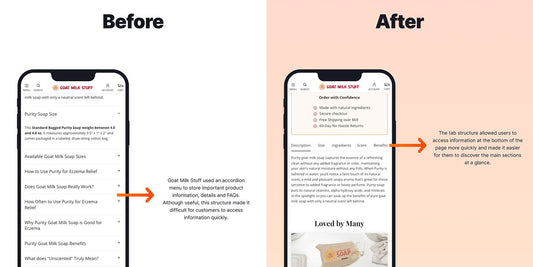Table of Contents
- 1. Personalisation is Becoming Future Orientated
- 2. Social Commerce
- 3. Authentic Content Will Reign Supreme
- 4. Think Mobile First
- 5. Customers will be sliding into the DMs
- 6. Continued Emphasis on Sustainability
- 7. Short Form Video Wins
- 8. AI Continues to Make Waves
- 9. Consumers Want Their Deliveries, & They Want Them Now
- 10. Subscriptions Alone Won’t Be Enough
- A Word From Blend
Get useful eCommerce stuff
To survive in the dynamic world of eCommerce, you have to be adaptable. Stay ahead of the curve with our curated list of 2024 trends where we explore the evolution of personalisation, social commerce, customer interactions, revamped subscriptions and more. Trust us, this isn’t something you want to miss out on.
1. Personalisation is Becoming Future Orientated
If personalisation isn't yet your eCommerce ally, then you’re already behind the curve. We suggest you catch up quickly because, in 2024, personalisation is only going to become more vital as customer expectations become even more intricate (woohoo).
According to data from Salesforce, “65% of customers now expect companies to adapt to their changing needs and preferences.”
So what does this mean for your eCommerce business?
Well, it means you can’t simply focus on who your customers are now; it's about predicting who they're going to become and anticipating their future needs (and how your brand can fulfil those needs).
Do we have a crystal ball? Not quite. But with the right tech stack, you’ll be pretty close. Consolidate and integrate your tech apps where possible, as this will allow you to collect data at every touchpoint, which you can then use the take actionable insights that will elevate your brand.
How to Achieve Advanced Personalisation
Achieving advanced personalisation involves a strategic blend of technology and insight. Here’s a short guide to help you navigate this landscape:
- Collect Zero-Party Data with Octane: Start by using platforms like Octane to collect zero-party data directly from your customers. This information is gold as it comes straight from the source—your customers—about their preferences, interests, and future intentions.
- Use Klaviyo for Deep Segmentation: Import this valuable data into Klaviyo as profile properties. This allows for sophisticated segmentation of your automated email flows. Consider segmenting your audience based on their interactions, preferences, or purchase history to ensure that each email speaks directly to them. Additionally, you can use Dynamic Content Blocks within your Klaviyo emails to further tailor your communication. Whether it's product recommendations or content tailored to each recipient's interests, these blocks make each email feel personally crafted for the reader.
- Extend Personalisation to Email Campaigns: Don't stop with email flows. Apply these principles to your broader email campaigns to enhance engagement and conversion rates. Speak directly to your customer, addressing their needs and how your products can meet them.
- Personalise Your Onsite Messaging: Beyond email, leverage tools like Nosto to personalise the onsite experience. From custom product recommendations to personalised content, these tools can significantly enhance the customer journey on your website.
2. Social Commerce
Social commerce has transformed the landscape of online shopping with platforms like Instagram Shopping and TikTok Shop leading the charge. The evolution of social media into shopping hubs provides brands with a golden opportunity to tap into new customer bases and elevate sales beyond mere brand visibility.
The Varied Landscape of Social Platforms
Each social media platform offers unique opportunities and challenges for brands looking to dive into social commerce, necessitating a nuanced understanding of each platform's user base. Instagram, with its visually-driven format, is ideal for fashion, beauty, and lifestyle brands. It appeals to a wide age range but is particularly popular among 18 to 34-year-olds, allowing brands to showcase their products in a visually compelling way. TikTok, known for its creativity and authenticity, captures the hearts of Gen Z and younger millennials, making it an excellent choice for brands aiming to engage with younger audiences through entertaining and original content. Tailoring content and marketing strategies to the specific demographics of each platform can significantly enhance engagement and conversion rates.
The Power of Influencer Marketing
Influencer marketing remains a key component of effective social commerce strategies. Collaborations with influencers can grant brands access to dedicated and engaged audiences, providing credibility and enhancing engagement in ways traditional advertising cannot match. Success in influencer marketing hinges on choosing influencers whose audience demographics align with your brand's target market and who resonate with the brand's ethos and values.
Organic Social Posting Versus Paid Social Advertising
Understanding the dynamics between organic social posting and paid social advertising is critical. Organic posts are essential for building a community and nurturing long-term relationships with customers, fostering a sense of loyalty and connection. And while organic reach is cost-effective, it's increasingly limited due to algorithm changes. Conversely, paid advertisements offer a way to target specific audiences with precision, driving immediate sales and conversions. Its costs can vary widely by platform and target audience. It's crucial to measure the return on ad spend (ROAS) to ensure your social commerce efforts are cost-effective. Platforms like Facebook and Instagram often offer detailed analytics to help track these metrics.
3. Authentic Content Will Reign Supreme
As the popularity of social commerce continues to grow, so does the concern among consumers about scams and fraud. According to a study conducted by Retail, more than half of respondents (53%) express a growing difficulty in trusting products sold through social channels.
This is true even in younger generations (Gen Z and Millenials). In this same study, over 60% of these younger respondents stated that they actively avoid making purchases through social media platforms due to worries about potential scams. Additionally, factors include a heightened awareness about the potential for encountering counterfeit or low-quality products and hesitancy regarding sharing their checkout information
So, how can you ease these pain points?
Prioritising the quality of your products is vital, as well as taking measures to highlight the authenticity and trustworthiness of your brand. The first factor will mainly be influenced by the suppliers you use. To emphasise your brand's authenticity, leverage user-generated content (UGC) and the help of nano- and micro-influencers to showcase the essence of your brand. Customer reviews and testimonials can be used to build trust among your audience.
Enhancing Brand Authenticity and Trust: A Practical Guide
To deepen the trust and authenticity of your brand in the eyes of potential customers, consider this practical guide:
- Leverage User-Generated Content (UGC): Encourage your customers to share their experiences with your products on social media. This not only provides social proof but also humanises your brand. UGC can range from unboxing videos to lifestyle photos showcasing your products in real-life scenarios.
- Utilise Nano- and Micro-Influencers: These influencers, often with smaller but highly engaged audiences, can lend a sense of authenticity and personal recommendation that resonates well with their followers. Their endorsement can serve as a powerful trust signal.
- Highlight Customer Reviews and Testimonials: Make sure customer reviews are front and centre on your social channels and website. Responding to both positive and negative reviews shows that you value customer feedback and are committed to improving your service.
- Showcase Trust Indicators: Include any stockists, media mentions, or logos of publications where your brand has been featured directly on your social media bios and website. A Linktree in your social media bios can direct customers to reviews, media mentions, and other trust-building content.
- Respond to Reviews, Especially Negative Ones: Demonstrating that you take customer concerns seriously and are proactive about resolving issues can significantly boost trust among potential customers.
- Adopt Well-Known Payment Gateways: Utilising recognised payment gateways not only ensures a secure transaction process but also reassures customers that their payment information is safe.
- Transparency: Be clear about your manufacturing process, sourcing, and the quality of your products. Transparency about your business practices can go a long way in building trust.
- Certifications and Awards: If applicable, highlight any certifications or awards your products or brand has received. These can serve as additional proof of your commitment to quality and reliability.
4. Think Mobile First
Our CEO, Adam Pearce, has emphasised a crucial point that many companies overlook: the predominance of mobile over desktop for online shopping. This perspective is not just anecdotal; it's statistically backed, with 75% of consumers expressing a preference for shopping online via their mobile devices, compared to just 15% who favour desktop.
Therefore, it's essential to pivot your website design strategy to be mobile-focused rather than desktop-centred. And if you’re unsure of your users’ shopping preferences, simply leverage insights from Shopify Analytics, which will give you an indication as to which device your customers prefer. If data indicates a mobile preference, adopting a mobile-first approach in design and functionality will become critical. How do you do this, you may be wondering? Here are a few points to consider.
Quick Checkout Solutions:
Apple Pay and Shop Pay: These platforms offer a 'quick checkout' feature that can dramatically speed up the transaction process, potentially improving conversion rates. By allowing users to checkout with their information preloaded, these services minimise the need for manual data entry, a common friction point that leads to high bounce rates.
PayPal: Similarly, PayPal offers a streamlined checkout experience, enabling users to complete purchases without entering shipping and billing information repeatedly. This convenience is particularly beneficial for mobile shoppers, who may find typing out details on a small screen cumbersome.
Encouraging Post-Purchase Account Creation:
To further streamline the mobile shopping experience and reduce friction, merchants can encourage customers to create an account after they have completed their purchase instead of before. This strategy can help maintain the momentum of a seamless checkout process by informing customers of the advantages that come with account creation, such as easier tracking of orders, a simplified returns process, access to special deals, and quicker future checkouts. You also have the option of installing and using Status, an app that keeps customers logged in to their accounts for longer periods. This convenience leads to increased engagement and simplifies future purchases, as their information will already be preloaded for quicker checkouts.
By focusing on these areas, merchants can significantly enhance the mobile shopping experience, ensuring that it is as convenient and user-friendly as possible.
5. Customers will be sliding into the DMs
Customers are increasingly reaching out to brands on their social media accounts. Why? Well, because customers simply seem to prefer it - around 60% according to the data. Considering the fact that social commerce is on the rise, we can expect this trend to follow suit.
While none of us can be online 24/7 to respond to queries, customers can, especially if they’re scattered across the globe. And we all know that customers nowadays expect quick if not immediate, responses.
For Shopify stores, it’s essential to have a diversified customer service strategy, which should include the adoption of technologies that will help facilitate these direct interactions with consumers. Tools like Gorgias work well with this, as they integrate directly with Instagram and Facebook DMs.
Enhancing Customer Service with Gorgias
To address the challenge of being available for customer inquiries around the clock, especially with the global nature of eCommerce, integrating a comprehensive customer service platform like Gorgias can be transformative for Shopify stores. Gorgias excels in collating communications from diverse channels, including email, chatbots, and social media platforms like Instagram and Facebook, into a single, easy-to-navigate dashboard. This centralised approach not only streamlines the management of customer interactions but also significantly improves response times.
One of the standout features of Gorgias is its ability to set up automations. For instance, stores can configure automatic responses to customer inquiries received outside of working hours, informing them of the expected wait time for a reply. This simple yet effective automation can manage customer expectations and enhance their experience by ensuring they're not left in the dark.
Furthermore, Gorgias allows brands to create Macros for frequently asked questions. This functionality enables the automatic delivery of pre-set answers to common queries, ensuring that customers receive immediate responses. Not only does this improve efficiency, but it also allows customer service teams to focus on more complex issues that require personalised attention.
6. Continued Emphasis on Sustainability
Sustainability has been high on consumers' agendas for some time now. In 2024, this trend will only continue to gain momentum.
Ethical sourcing, sustainable packaging and a reduction of waste are all aspects you can look into for your business. While it might cause an increase in your costs, the impact it will have on your relationship with your customers will be far more significant.
According to a study conducted by First Insight and the Baker Retailing Center, consumers - regardless of age - are willing to spend more money on a product that is sustainable.
But do it truthfully. As you make your business more sustainable, it's important to authentically communicate your efforts to avoid greenwashing—a practice where companies misleadingly promote their products as environmentally friendly. To steer clear of this, ensure your sustainability claims are transparent and backed by evidence. Honesty about your journey, including both achievements and areas for improvement, helps build trust with your audience. Remember, genuine sustainability efforts resonate more deeply with consumers and can significantly enhance your brand's reputation and customer loyalty.
7. Short Form Video Wins
When you hear 'short-form video,' your mind may instantly jump to TikTok and Reels. These platforms offer valuable channels to promote and sell your products, but the potential of short-form video content extends even further. Defined by its brief duration, typically less than 60 seconds, short-form video is designed to capture the viewer's attention quickly and convey messages in a digestible format. This makes it an ideal tool for educating consumers, particularly younger demographics, about your brand and products.
This trend offers a golden opportunity for businesses that leverage user-generated and influencer content, as well as those looking for the right moment to dive in. Beyond TikTok and Instagram Reels, short-form videos are also gaining traction on platforms like Snapchat's Spotlight and YouTube Shorts, broadening the avenues for engagement.
Integrating short-form video into your eCommerce strategy can be as straightforward as showcasing your team and company culture with behind-the-scenes footage or educating consumers about your products through demo videos. These clips do more than just captivate audiences; they play a pivotal role in boosting conversions by providing a quick and engaging way to communicate your brand's value and product benefits.
8. AI Continues to Make Waves
AI and automation are significantly transforming the eCommerce landscape, offering brands innovative ways to enhance efficiency and creativity. These technologies enable the automation of repetitive tasks and the generation of new content, from ideation to execution. For instance, AI platforms like Jasper and Writesonic are increasingly popular for generating content ideas and drafting product descriptions, while tools such as DALL·E and Canva's Magic Write feature provide capabilities for creating compelling images.
As we step into 2024, the focus is shifting towards leveraging AI and machine learning more strategically, particularly in analysing customer data. This advancement is not just about predicting consumer behaviours; it's about using insights to formulate precise marketing strategies that yield significant impact.
Deepening AI Integration in eCommerce Strategy
The potential of AI extends far beyond operational efficiency. Platforms like ChatGPT can be utilised to generate content that not only resonates with your audience but also maintains your brand's tone of voice. When prompting AI tools, it's crucial to direct them to identify gaps in content and suggest improvements, ensuring the output aligns with your brand identity and messaging strategy.
Moreover, the integration of AI in eCommerce platforms and tools is rapidly evolving. Rebuy AI, for example, offers sophisticated product recommendation engines that integrate seamlessly with Shopify, enhancing the shopping experience through personalised suggestions. Similarly, Klaviyo is incorporating AI into its email design templates, enabling merchants to craft more effective and engaging email marketing campaigns.
Working Smarter with AI-Enhanced Tools
AI-enhanced technologies not only streamline content creation and operational tasks but also offer deep insights into customer preferences and behaviours that can be used to save you time and show you where to focus your efforts. However, it’s essential to ensure that any content created with AI maintains your brand's unique tone of voice and personalisation. This balance between efficiency and authenticity is key to creating compelling, AI-generated content that truly resonates with your audience.
As AI continues to influence product development across various eCommerce apps and platforms, merchants should stay informed about the latest advancements and consider how these technologies can be integrated into their strategies. By doing so, brands can harness the power of AI to not only optimise their operations but also to create more personalised, engaging, and effective marketing strategies.
9. Consumers Want Their Deliveries, & They Want Them Now
It's no secret that fast delivery has become a staple expectation for online shoppers. Over 40% of U.S. customers anticipate their online orders to arrive within two to three days, and nearly a third expect next-day delivery, according to Statistisa.
For eCommerce giants like Amazon, Walmart and ASOS, this isn’t an issue. They can simply build more delivery service points, allowing them to process and deliver orders within a matter of hours. But how can your eCommerce business keep up?
Well, Shopify Shipping does offer merchants the ability to send packages overnight. So, in 2024, start offering and promoting this service to your customers - it may just be the factor that causes them to convert. But what do you do when expedited delivery isn’t feasible?
We’ve got a few alternative strategies that can help manage customer expectations and maintain satisfaction:
Transparent Communication: Be clear about your shipping timelines from the outset. Accurate, upfront information about dispatch and delivery times helps set realistic expectations.
Under Promise and Over Deliver: If you estimate a delivery window of five days, aim to deliver in three or four. This strategy not only surprises and delights customers but also builds trust and loyalty.
Post-Purchase Engagement: Use platforms like Klaviyo to keep customers informed every step of the way. From order confirmation to shipping updates and delivery notifications, regular touchpoints can enhance the customer experience.
Customer Service Excellence: Ensure your customer service team is accessible and responsive. Quick and helpful responses to inquiries about shipping and delivery can mitigate frustration and maintain a positive perception of your brand.
10. Subscriptions Alone Won’t Be Enough
In the face of rising inflation rates, consumers are becoming increasingly mindful of their spending. The allure of discounted subscriptions as a means to boost customer retention is waning, prompting a need for businesses to evolve their strategies. Today's consumers are in pursuit of more substantial savings and value from their subscriptions, making it crucial for businesses to adapt and innovate.
To resonate with the current market dynamics, consider repositioning your subscription offerings. Moving beyond mere savings, focus on the convenience and ease that subscriptions can bring to your customers' lives. The concept of "Autoship" has gained traction, appealing to consumers by eliminating the hassle of remembering to reorder essentials. This approach not only ensures a steady stream of products for the consumer but also fosters a sense of loyalty and reliance on your brand.
You Need Enhanced Subscription Management
To keep subscribers engaged and satisfied, it's essential to make subscription management effortless and flexible. Solutions like Relo come into play here, offering sophisticated automation for subscription management. Through timely emails or SMS reminders, subscribers are informed about upcoming orders, with the added flexibility to modify their subscription as needed. This can include options to:
- Delay shipment if the customer isn’t ready for a new order,
- Change the product in their subscription to try something new or replace an item that didn’t meet their needs,
- Add products to their existing subscription, perhaps incentivised by additional savings or rewards,
- Skip a delivery without penalty, accommodating for changes in consumption patterns or absence.
By implementing these strategies, businesses can transform their subscription services into a valuable, customer-centric offering. This not only addresses the desire for meaningful savings but also enhances the overall customer experience by providing unparalleled flexibility and control. In a market where consumers are more discerning and cautious about their expenditures, tailoring your subscription model to meet these evolving needs can set your brand apart and ensure sustained growth and customer loyalty.
A Word From Blend
To thrive in the evolving world of eCommerce, it's crucial to stay ahead of the curve. At Blend, we're committed to being your strategic partners through every shift and trend.
Here’s a checklist based on our insights into the major eCommerce trends for 2024, designed to help you implement these recommendations effectively:
Personalisation
✅ Collect Zero Party Data: Use platforms like Octane to gather direct customer insights.
✅ Segment and Personalise with Klaviyo: Import data into Klaviyo for sophisticated email flow segmentation and make use of Dynamic Blocks to tailor communications.
✅ Onsite Personalisation: Implement tools like Nosto for custom product recommendations.
Social Commerce
✅ Platform Diversification: Focus on Instagram for visuals and TikTok for creativity.
✅ Influencer Partnerships: Collaborate with nano- and micro-influencers to enhance trust.
✅ Balance Organic and Paid Content: Use analytics to optimise your social commerce strategy.
Authentic Content
✅ Leverage UGC: Encourage sharing of customer experiences on social media.
✅ Manage Reviews: Showcase customer reviews prominently and respond actively.
✅ Highlight Trust Indicators: Use stockists, media mentions, and certifications to build credibility.
Mobile Optimisation
✅ Adopt a Mobile-First Design: Ensure your site is optimised for mobile users.
✅ Quick Checkout Solutions: Integrate Apple Pay, Shop Pay, and PayPal for seamless transactions.
✅ Post-Purchase Account Creation: Encourage account sign-ups after purchase for future ease.
Customer Interactions
✅ Utilise Gorgias: Integrate for centralised communication management.
✅ Automate Communications: Set up reminders and options for order management.
Sustainability
✅ Communicate Authentically: Avoid greenwashing by being transparent about your sustainability efforts.
Short-Form Video
✅ Explore Platforms: Use TikTok, Instagram Reels, Snapchat Spotlight, and YouTube Shorts.
✅ Content Strategy: Focus on demo videos and behind-the-scenes footage.
AI Integration
✅ Content and Analytics: Use platforms like Jasper for content and ChatGPT for insights.
✅ Enhance with AI: Leverage AI in tools like Rebuy for recommendations and Klaviyo for email marketing.
Fast Delivery
✅ Offer Expedited Shipping: Consider Shopify Shipping for overnight options.
✅ Manage Expectations: Communicate clearly about shipping times and offer updates.
Subscriptions
✅ Autoship Convenience: Highlight the ease of automatic reordering.
✅ Flexible Management: Use platforms like Relo for subscriber autonomy.
From enhanced personalisation to leveraging authentic content, 2024 is set to be an exciting year in eCommerce. At Blend, we're your strategic partners, guiding you through these dynamic trends. Ready to transform these insights into actions? Get in touch today.
About the author

Jo Badenhorst UX Strategist
The vibrant heart of Blend Commerce, Jo has an infectious enthusiasm for taking on new challenges, making her a driving force in our team. With a deep background in psychology, Jo looks beyond the data to truly understand the motivations behind customer actions, making her approach to eCommerce both thoughtful and effective. With Jo as part of our team, we’re not just working; we’re creating, innovating, and setting new standards in the eCommerce world.








